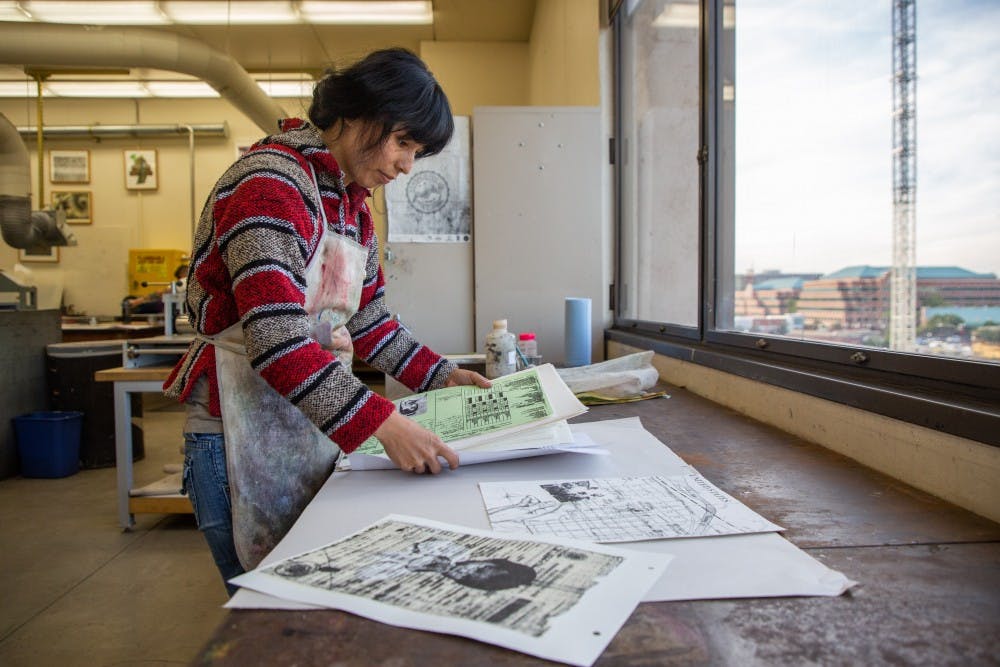When Gloria Casillas-Martinez got her first report card in the U.S. as an eight-year-old, little did she know of the impact that the document would have on her life.
Casillas-Martinez migrated to the U.S. in 1992 from Guanajuato, Mexico. She said she had high hopes as a young child about life North of the border. Twenty six years later, she's now a DACA recipient and studies printmaking at ASU. She hopes to use her art to start conversations about undocumented people.
“I remember thinking, ‘what would it be like to live in the U.S?’, and I would imagine big buildings and shiny lights,” Casillas-Martinez said. “It was not exactly what I expected, but it was definitely better than what I was used to.”
She said that, although her family was able to stay together and surpass language barriers and prejudice together, she still faced rejection.
“That rejection made me anxious.” Casillas-Martinez said. ”That’s also why I put it in my work – it's important.”
She got the idea to print documents she had accumulated throughout her life in the U.S. during the fall semester of her junior year when she took a lithography class. Casillas-Martinez said that it was her mother who kept all of her documents throughout the years in case they could someday use them to update their legal status.
“When president Barack Obama announced DACA in 2012 — which is the deferred action for childhood arrivals — I asked (my mom) if she had anything, and she handed me stacks of paperwork of report cards and certificates I gained in school,” she said. “As I started printing them, they started telling a story.”
She chose to take an individual instruction class her following semester to continue the process.
Casillas-Martinez decided to continue printing using only lithography, a technique she described as arduous, but perfect for the occasion.
“The fact that it’s on a stone just romanticized the whole idea of it,” she said. “It's very unique, and the same thing could be said about the situations that we find ourselves in as DREAMers because when you look at it, a lot of the dreamers come from families that, if their families had stayed where they were brought from, they might not have been able to get where they are today."
Janet Diaz, a graduate teaching assistant at the School of Art, said the process of lithography starts with a lithograph stone, made out of limestone, which is then marked with anything oil-based.
“The stone will remember oils from your hand or even a pizza,” Diaz said. “You press it on the stone using nitric acid as part of the process.”
Casillas-Martinez photoshopped desired images such as portraits of herself onto her documents before printing them to give them a new meaning.
“You can use acetone to transfer those digital files onto the stone, which also keeps this process modern even though it comes from way back in the day.” Diaz said.
Rogelio Gutierrez, associate professor in the School of Art, instructed Casillas-Martinez in three of her courses at ASU. He said that he has seen how Casillas-Martinez appreciates her education and that her desire to learn is shown in her work.
“Being able to see her grow as an artist is really amazing” Gutierrez said. “I see the people around her impressed with this idea.”
Casillas-Martinez hopes to use her art to impact those who may not understand her struggle.
“Here I am being called an undocumented illegal which portrays me as a criminal, and my documents prove that to be the opposite: that I’m a good student, that I’ve excelled as a citizen and that I’m being treated unfairly.”
Casillas-Martinez will continue to work on her prints throughout the rest of her senior year and hopes to include them in her senior showcase.
“Not everybody understands," she said. "But I think the more there is conversations around this, it'll be a healing experience for all.”
Correction: A previous version of this story misstated the time that it's been since Casillas-Martinez came to the U.S. The article has been updated to reflect this change.
Reach the reporter at icrespo@asu.edu and follow @ziacrespo on Twitter.
Like The State Press on Facebook and follow @statepress on Twitter.




